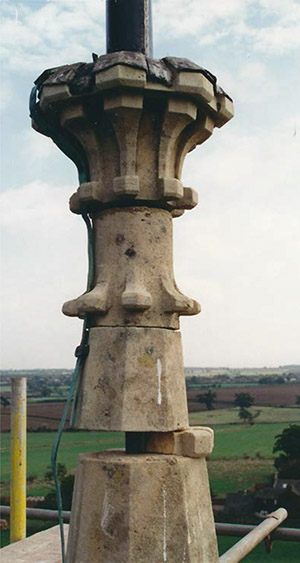Lightning protection: the new standard explained
 In May Historic England began a series of webinars aimed at providing technical guidance for owners and operators of historic buildings, as well as contractors and heritage professionals. Tagged as Technical Tuesdays, the webinars are presented by senior members of Historic England’s technical conservation team.
In May Historic England began a series of webinars aimed at providing technical guidance for owners and operators of historic buildings, as well as contractors and heritage professionals. Tagged as Technical Tuesdays, the webinars are presented by senior members of Historic England’s technical conservation team.
Each Tuesday in the week sees a webinar on a theme within a particular area of expertise. On 21 July the theme was Lightning Protection. It was presented by Historic England senior building services engineer Geraldine O’Farrell and the team leader of building services and principal engineer, Caroline Cattini.
The session began with a brief explanation of what the webinar was aiming for. At base, it was to offer an explanation of Historic England’s guidance document for the new BS EN 62305 standard.
Caroline Cattini added that there was also an aim to enable delegates to become ‘the informed client’, able to discuss requirements with designers and contractors.
Both stressed that the design and installation of a lightning protection system is very much the job of a trained expert, while indicating that – heresy of heresy – it is not always essential to stick rigidly to the standard where it would be at odds with the need to preserve a historic building’s unique identity.
Getting down to the technical nitty-gritty, the duo explained the changes from the previous standard, BS 6651.
Geraldine then explained what lightning was from a scientific standpoint, together with some mindboggling statistics regarding the temperature, electrical power and speed of lightning.
The whole was illustrated by a comprehensive series of slides illustrating the complex process of designing and installing a lightning protection system – some taken from the English Heritage guidance, others from the standard document.
A series of photographs illustrated the awesome power of lightning, together with the effect it can have on buildings. A series of pictures showed the strike on St Andrew’s Church in Ramsbottom. The tower carried only a single down tape on a corner pinnacle. When the lightning struck it hit that pinnacle and also another, which was blown apart and ripped through the church roof. The pictures showed both the damage to the tower itself and to the interior (pictured top).
 Another showed the effect of a ‘side flash’ on the pinnacle of Easton Maudit church in Northamptonshire. Amazingly, the middle section of the pinnacle was nearly blown out, leaving the top teetering (pictured left).
Another showed the effect of a ‘side flash’ on the pinnacle of Easton Maudit church in Northamptonshire. Amazingly, the middle section of the pinnacle was nearly blown out, leaving the top teetering (pictured left).
The webinar then went on to explain the three main elements of a lightning protection system. First of all comes the air termination element – the familiar ‘lightning conductor’ spike. In the case of historic buildings a major concern is that terminals should not make an ‘undesirable mission statement of their own’.
The same applies to the second element – the down conductors. They should be nestled into corners or run alongside downspouts – the downspout should not, however, be part of the system.
Consideration should also be given to the anchoring clips. They should be fixed into ‘sacrificial’ materials such as mortar and not into ashlars.
Unfortunately, the metal of the down conductors can be a target for thieves. Geraldine and Caroline offered the story of a church in Liverpool where the cable was attached to a 4x4 vehicle and pulled off the wall. The irony was that the police arrived to disrupt the thieves and the damage was caused for nothing.
The final element of the basic system is the route to earth. A number of slides illustrated the kind of end terminal that can be employed. Things to avoid with a system were listed. In particular, bends in the down conductor should be avoided. Where bends cause overhangs there is the risk a strike could ‘jump’ across to earth directly.
The webinar concluded with a consideration of testing. While the generally accepted interval for testing is 12 months, a preferable interval is, in fact, 11 months. That ensures the testing takes place at different months over the years, thus taking into account seasonal variations.
All the link references and slides of the webinar have been made available to download, as is the guidance document itself. Visit historicengland.org.uk, where details of all the other Technical Tuesdays webinars are available.













